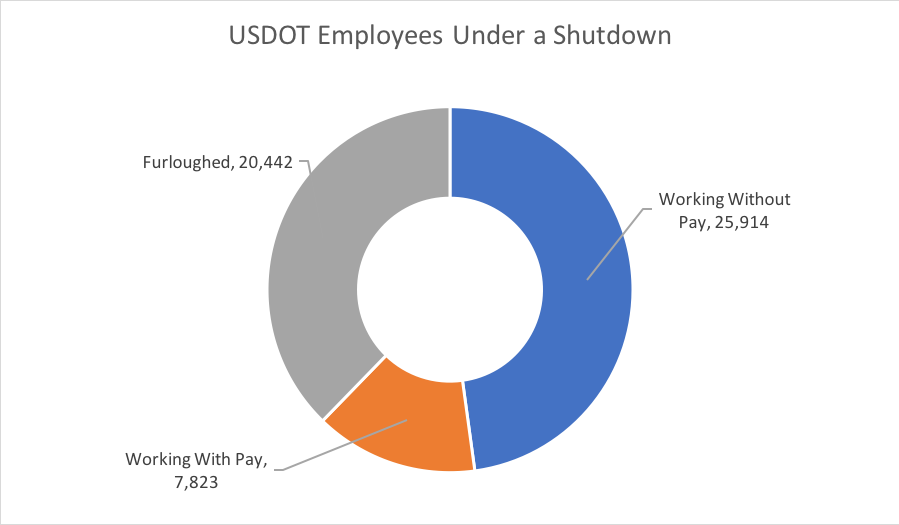December 21, 2018
The partial shutdown of the federal government that will take effect at midnight tonight would furlough 38 percent of U.S. Department of Transportation employees and force another 46 percent to work without the guarantee of being paid. Just 14 percent of USDOT employees would continue to work and be paid as normal. (See this article in today’s issue for the prospects of ending the shutdown swiftly.)

Most federal employees affected by a shutdown that starts at midnight tonight would not begin to see the effects of the shutdown until Wednesday morning unless they normally work weekends, since Tuesday (Christmas Day) is a federal holiday and since the President recently signed an order giving everyone Christmas Eve off from work. If a shutdown lasts that long, employees would presumably be summoned to work on Wednesday morning to be given formal furlough notices.
Even though the federal employees deemed essential are forced to work without a legally binding promise of pay, Congress has always enacted special legislation after government shutdowns providing retroactive pay.
Even at an agency (like DOT) where the annual appropriations bill has not been enacted into law, not all funding lapses. Some accounts paid out of the annual appropriations bills get part of their funding at least a year in advance (some of the FAA capital programs, for example) and those appropriations won’t lapse tonight. And employees paid by trust fund contract authority, or some offsetting fees, or other revolving or franchise funds also won’t see their funds lapse. Accordingly, a shutdown will not affect anyone at FHWA, FMCSA or the St. Lawrence Seaway and also will exempt a significant number of employees at FAA, MARAD, NHTSA, and the Office of the Secretary. Employees whose salaries are supported by that kind of funding will keep showing up for work – and getting paid – as normal.
Other exceptions in the AntiDeficiency Act, as interpreted by the Carter Administration’s Attorney General opinions, require some obligations to continue to be incurred in the absence of budget authority. These categories are:
- Obligations “necessarily incident to presidential initiatives undertaken within his constitutional powers.” Where transportation is concerned, this really only applies to foreign relations, so the people at FAA and MARAD that represent the U.S. to foreign governments and transportation ministries are exempt under this exemption and have to continue working without the immediate prospect of pay.
- Obligations “some reasonable and articulable connection between the function to be performed and the safety of human life or the protection of property.” This is the big exception, which includes air traffic controllers, and safety inspectors in the aviation, rail, pipeline, maritime and transit modes. These employees would have to continue working without the immediate prospect of pay.
- Obligations “authorized by necessary implication from the specific terms of duties that have been imposed on, or of authorities that have been invested in, the agency.” This category is a bit more vague and is mostly used in the DOT shutdown plan at FAA and OST. These employees would have to continue working without the immediate prospect of pay.
- Presidential employees confirmed by the Senate. Here is what OPM has to say about these: “leave-exempt Presidential appointees are not subject to furloughs because they are considered to be entitled to the pay of their offices solely by virtue of their status as an officer, rather than by virtue of the hours they work. In other words, their compensation is attached to their office, and, by necessary implication of the President’s authority to appoint such employees, their service under such an appointment creates budgetary obligations without the need for additional statutory authorization.”
The new shutdown plan from USDOT divides its 54,179 employees into those five categories, as follows.
Employees Affected by USDOT Shutdown Plan – December 19, 2018
|
|
Pres. |
|
|
|
|
|
|
|
Duties/ |
Life/ |
Support |
Confirmed |
Other |
Furloughed |
TOTAL |
|
Powers |
Safety |
Activities |
by Senate |
Funding |
Staff |
EMPLOYEES |
| FAA |
62 |
24,208 |
571 |
0 |
2,297 |
17,791 |
44,929 |
| FHWA |
0 |
0 |
0 |
0 |
2,682 |
0 |
2,682 |
| NHTSA |
0 |
0 |
8 |
0 |
245 |
331 |
584 |
| FMCSA |
0 |
0 |
0 |
0 |
1,156 |
0 |
1,156 |
| FTA |
0 |
9 |
6 |
0 |
50 |
493 |
558 |
| FRA |
0 |
497 |
23 |
1 |
0 |
408 |
929 |
| PHMSA |
0 |
262 |
15 |
1 |
0 |
285 |
563 |
| MARAD |
10 |
27 |
15 |
1 |
287 |
419 |
759 |
| StLSDC |
0 |
0 |
0 |
0 |
126 |
0 |
126 |
| OST |
0 |
21 |
71 |
5 |
971 |
406 |
1,474 |
| OIG |
0 |
104 |
5 |
1 |
0 |
309 |
419 |
| TOTAL |
72 |
25,128 |
714 |
9 |
7,814 |
20,442 |
54,179 |
|
0.1% |
46.4% |
1.3% |
0.0% |
14.4% |
37.7% |
100.0% |
The percentage of employees subject to the life/safety exception is much higher at the Department of Homeland Security, according to its updated shutdown plan. At the Transportation Security Administration, 55,182 of the total 60,078 employees would work during a shutdown. At the Coast Guard, 44,298 of the 50,861 employees would work during a shutdown. Most of those, again, fall under the life/safety exception.




